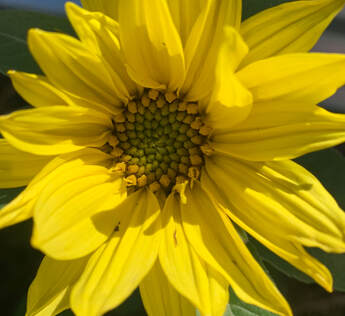|
The Sunflower is part of the Helianthus genus and the Asteraceae family. Sunflowers are very accessible, both in cities and in rural areas of North America. If you have ever grown your own Sunflowers, purchased them at the grocery store, or picked them from the farm, you may understand when I say how they spread joy and happiness to those around them. They brighten the area like the Sun. The Sunflowers, via stretching their stems, actually do follow the path of the Sun. The path of following the Sun from East to West is called rhythmic tracking and allows for optimal growth for the Sunflower (Crespi, 2016). There have been further studies on Sunflowers who face East versus West. Those facing East have increased visits from pollinators, such as bees, during the daytime. The increase is so profound, that it is five times more than those not facing the same direction (Crespi, 2016). At the very center of the Sunflower, there are also two spiraling systems that begin from the center. With what we know about symmetrical growth in Nature, one would assume that the spiraling effect in Sunflowers also follows the same rule, but it does not. The number of spirals from the center, that are both clockwise and counterclockwise, are not equal in number. The ones who did have the time to count the number of clockwise and counterclockwise spirals noted that those numbers are true to showing the pattern of successive Fibonacci numbers. “The number of spirals in two directions may be 21 and 34, or they may be 8 and 13” (Hemenway, 2005). Fibonacci Sequence: 0, 1, 1, 2, 3, 5, 8, 13, 21, 34, 55, 89, 144, 233, 377, 610, 987, 1597, 2584, 4181, 6765, 10946, 17711, 28657, 46368, 75025, 121393, 196418, 317811, ... What is fascinating is that our Sunflowers- Helianthus spp. follow this Mathematical system of numbers in the Fibonacci sequence and also follow a rhythmic system. These are patterns that are part of their health, their wellbeing. Before you venture out into the garden, the grocery store, or to the local farm, think about observing like a Mathematician, or Scientist. Think about growing your own Sunflowers at home. Make observations and find more stories that Helianthus spp. wants to share on how to live in the patterns of Mathematics in Nature. Many Blessings References: Heatherley, A. (1998). Healing Plants: A Medicinal Guide to Native North American Plants and Herbs. (pgs. 211-212). The Lyons Press. Hemenway, Priya. (2005). Divine Proportion: Phi in Art, Nature, and Science. (pg. 137). 1st edition. Sterling Publishers. Crespi, S. (April 2016) Science Magazine: Why Young Flowers Follow the Sun. https://www.sciencemag.org/news/2016/08/why-young-sunflowers-follow-sun
0 Comments
Leave a Reply. |
AuthorI am not the first, nor the last of expressing and sharing the beauty of mathematics in Nature. What I will share in this blog are thoughts, experiences, and lessons learned to validate life, both human and botanical, living mathematically. Archives
September 2021
Categories
All
|


 RSS Feed
RSS Feed
